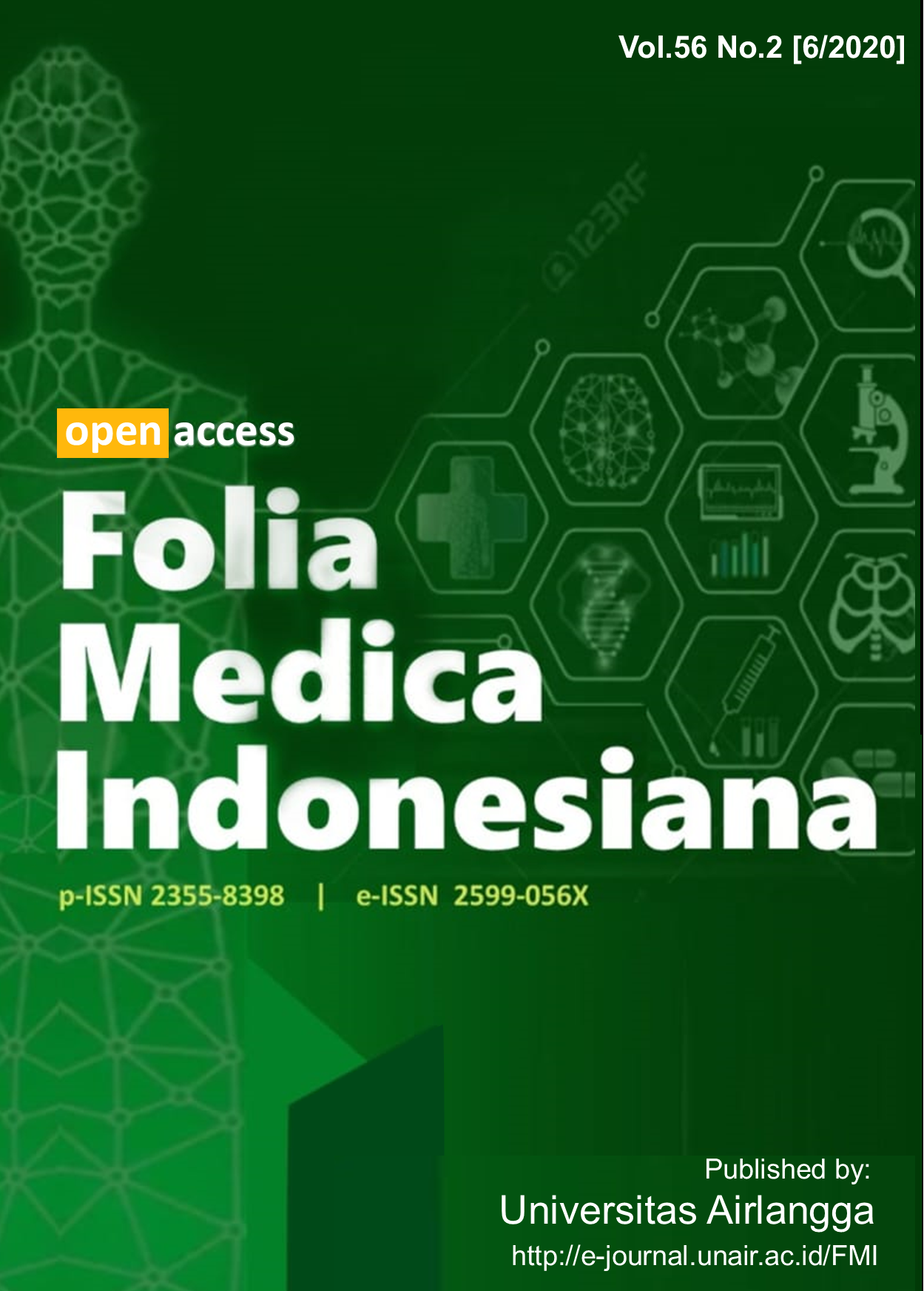Main Article Content
Abstract
Keywords
Article Details
Copyright (c) 2020 Folia Medica Indonesiana

This work is licensed under a Creative Commons Attribution-NonCommercial-ShareAlike 4.0 International License.
-
Folia Medica Indonesiana is a scientific peer-reviewed article which freely available to be accessed, downloaded, and used for research purposes. Folia Medica Indonesiana (p-ISSN: 2541-1012; e-ISSN: 2528-2018) is licensed under a Creative Commons Attribution 4.0 International License. Manuscripts submitted to Folia Medica Indonesiana are published under the terms of the Creative Commons License. The terms of the license are:
Attribution ” You must give appropriate credit, provide a link to the license, and indicate if changes were made. You may do so in any reasonable manner, but not in any way that suggests the licensor endorses you or your use.
NonCommercial ” You may not use the material for commercial purposes.
ShareAlike ” If you remix, transform, or build upon the material, you must distribute your contributions under the same license as the original.
No additional restrictions ” You may not apply legal terms or technological measures that legally restrict others from doing anything the license permits.
You are free to :
Share ” copy and redistribute the material in any medium or format.
Adapt ” remix, transform, and build upon the material.

References
- Ehni, G. (1982). Reduction of Head Size in Advanced Hydrocephalus: A Case Report. Neurosurgery, 11(2), 223–228.
- Erdinçler, P., Kaynar, M. Y., Canbaz, B., Etuş, V., Çiplak, N., & Kuday, C. (1998). Two different surgical techniques for reduction cranioplasty. Child's Nervous System, 14(8), 372–377. http://doi.org/10.1007/s003810050247
- Manwaring, J. C., Truong, D., Deukmedjian, A. R., Carey, C. M., Storrs, B. B., Rodriguez, L. F., ... Tuite, G. F. (2013). Cranial reduction and fixation with a resorbable plate combined with cerebrospinal fluid shunting for difficult-to-manage macrocephaly related to hydrocephalus. Journal of Neurosurgery: Pediatrics, 11(2), 210–213. http://doi.org/10.3171/2012.10.PEDS12340
- Mathews, M. S., Loudon, W. G., Muhonen, M. G., & Sundine, M. J. (2007). Vault reduction cranioplasty for extreme hydrocephalic macrocephaly. Journal of Neurosurgery: Pediatrics, 107(4), 332–337. http://doi.org/10.3171/PED-07/10/332
- Park, T. S., Gready, M. S., Persing, J. A., & Delashaw, J. B. (1985). One-stage Reduction Cranioplasty for Macrocephaly Associated with Advanced Hydrocephalus. Neurosurgery, 17(3), 506–509.
- Piatt, J. H., & Arguelles, J. H. (1990). Reduction Cranioplasty for Craniocerebral Disproportion in Infancy: Indications and Technique. Pediatric Neurology, 16, 265–270.
- Sundine, M. J., Wirth, G. A., Brenner, K. A., Loudon, W. G., Muhonen, M. G., Greene, C. S., Sabzghagaei, N. (2006). Cranial Vault Reduction Cranioplasty in Children with Hydrocephalic Macrocephaly. Journal of Craniofacial Surgery, 17(4), 645–655. http://doi.org/10.1097/00001665-200607000-00007
- Ventureyra, E. C. G., & Da Silva, V. F. (1980). Reduction Cranioplasty for Neglected Hydrocephalus. Surgical Neurology, 15(3), 236–238.
- Vries, J. K., & Habal, M. B. (1979). Cranio-Orbital Correction for Massive Enlargement of the Cranial Vault. Plastic and Reconstructive Surgery Reconstructive Surgery, 63(4), 466–472.
- Winston, K. R., Ogilvy, C., & McGrail, K. (1995). Reduction Cranioplasty. Pediatric Neurosurgery, 22, 228–234.
References
Ehni, G. (1982). Reduction of Head Size in Advanced Hydrocephalus: A Case Report. Neurosurgery, 11(2), 223–228.
Erdinçler, P., Kaynar, M. Y., Canbaz, B., Etuş, V., Çiplak, N., & Kuday, C. (1998). Two different surgical techniques for reduction cranioplasty. Child's Nervous System, 14(8), 372–377. http://doi.org/10.1007/s003810050247
Manwaring, J. C., Truong, D., Deukmedjian, A. R., Carey, C. M., Storrs, B. B., Rodriguez, L. F., ... Tuite, G. F. (2013). Cranial reduction and fixation with a resorbable plate combined with cerebrospinal fluid shunting for difficult-to-manage macrocephaly related to hydrocephalus. Journal of Neurosurgery: Pediatrics, 11(2), 210–213. http://doi.org/10.3171/2012.10.PEDS12340
Mathews, M. S., Loudon, W. G., Muhonen, M. G., & Sundine, M. J. (2007). Vault reduction cranioplasty for extreme hydrocephalic macrocephaly. Journal of Neurosurgery: Pediatrics, 107(4), 332–337. http://doi.org/10.3171/PED-07/10/332
Park, T. S., Gready, M. S., Persing, J. A., & Delashaw, J. B. (1985). One-stage Reduction Cranioplasty for Macrocephaly Associated with Advanced Hydrocephalus. Neurosurgery, 17(3), 506–509.
Piatt, J. H., & Arguelles, J. H. (1990). Reduction Cranioplasty for Craniocerebral Disproportion in Infancy: Indications and Technique. Pediatric Neurology, 16, 265–270.
Sundine, M. J., Wirth, G. A., Brenner, K. A., Loudon, W. G., Muhonen, M. G., Greene, C. S., Sabzghagaei, N. (2006). Cranial Vault Reduction Cranioplasty in Children with Hydrocephalic Macrocephaly. Journal of Craniofacial Surgery, 17(4), 645–655. http://doi.org/10.1097/00001665-200607000-00007
Ventureyra, E. C. G., & Da Silva, V. F. (1980). Reduction Cranioplasty for Neglected Hydrocephalus. Surgical Neurology, 15(3), 236–238.
Vries, J. K., & Habal, M. B. (1979). Cranio-Orbital Correction for Massive Enlargement of the Cranial Vault. Plastic and Reconstructive Surgery Reconstructive Surgery, 63(4), 466–472.
Winston, K. R., Ogilvy, C., & McGrail, K. (1995). Reduction Cranioplasty. Pediatric Neurosurgery, 22, 228–234.

